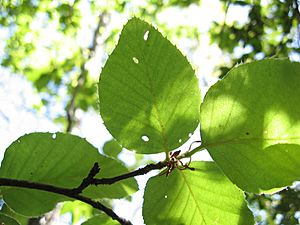Ruil facts for kids
Quick facts for kids Ruil |
|
|---|---|
 |
|
| Conservation status | |
| Scientific classification | |
| Genus: |
Nothofagus
|
| Species: |
alessandrii
|
| Synonyms | |
|
Fuscospora alessandrii (Espinosa) Heenan & Smissen (2013) |
|
The ruil (scientific name: Nothofagus alessandrii) is a special type of plant that belongs to the Nothofagaceae family. These trees are often called southern beeches. The ruil tree is found only in Chile, mainly in an area called the Chilean matorral. Sadly, it is in danger because its natural home is shrinking. To help protect it, the species is kept safe inside the Los Ruiles National Reserve.
Contents
What the Ruil Tree Looks Like
The ruil is a tree that loses its leaves in the fall, just like many trees in colder places. It has a straight, gray trunk that can grow very tall, up to 30 meters (about 98 feet).
Its leaves are shaped like an egg, a heart, or a spear. They have clear veins and jagged edges, like a saw. The flowers are small and greenish, and you might not notice them much. Each tree has both male and female flowers.
Where the Ruil Tree Lives
The ruil tree grows in a specific part of Chile. You can find it between 37º 05' and 37º 50' south latitude. This area is in the Chilean Coast Range, specifically in the Talca and Cauquenes provinces of the Maule Region.
The total area where the ruil tree could possibly live is about 755 square kilometers (292 square miles). However, the actual area where it lives is much smaller, around 116 square kilometers (45 square miles).
The ruil is a key tree in a plant community called the Maulino forest. This forest is a mix between the dry, Mediterranean-like Chilean matorral of Central Chile and the wet, mild Valdivian temperate forests found further south in Chile.
How the Ruil Tree Survives
In its natural home, the ruil tree has a special partnership with a type of fungus called Cenococcum geophilum. This fungus lives on the tree's roots. It helps the ruil trees get water and nutrients, which is especially helpful when there isn't much rain. This partnership helps the trees survive dry periods.
Protecting the Ruil Tree
Scientists believe that the ruil trees we see today are just small parts of what used to be a much larger forest. A study from 1988 showed that the trees are spread out across about 185 small pieces of land. Each of these areas is only one or two hectares (about 2.5 to 5 acres) in size.
These small groups of ruil trees are surrounded by large farms and plantations of Pinus radiata. This pine tree is not native to Chile; it was brought there from other places. These pine plantations and farms make it hard for the ruil tree's habitat to grow bigger.
Pine plantations can easily catch fire, and climate change can make these wildfires even worse. Wildfires are now the biggest danger to the ruil tree. For example, the big 2017 Chile wildfires destroyed 45% of the area where the ruil tree lives. The fire also wiped out the trees at a place called Piedra del Montaña.
To help protect this special tree, the Los Ruiles National Reserve was created. This reserve has two separate areas that together cover 45 hectares (about 111 acres). It protects one of the largest remaining forests where the ruil tree still grows.
Ruil Tree Hybrids
Sometimes, the ruil tree can mix with other types of trees. For example, it can create a hybrid species called Nothofagus × eugenananus. This happens when the ruil tree crosses with the red beech tree, which comes from New Zealand.
See also
 In Spanish: Ruil para niños
In Spanish: Ruil para niños


